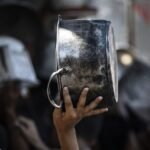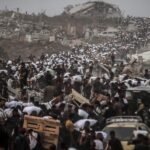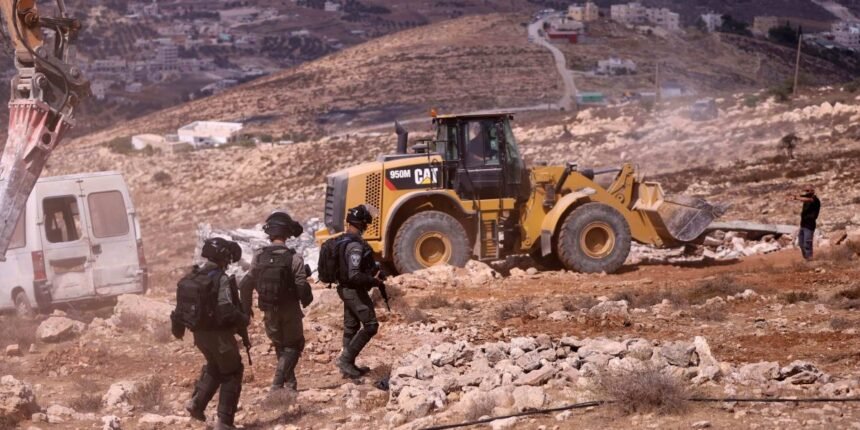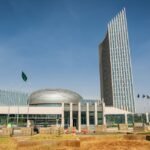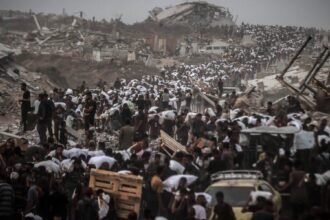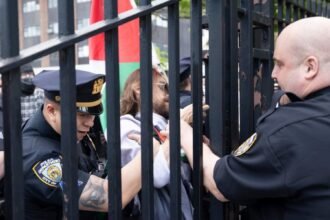24 Daily News
DURA, OCCUPIED WEST BANK — As recently as Christmas, this small community near Hebron thought it had a deal with the United States to tackle one of its most pressing issues: water supply.
In December, Dura joined the municipalities of Halhul and Hebron to sign a memorandum with the U.S. Agency for International Development to fund a $46 million program shoring up their local water systems.
It was a project of tremendous local import. The three neighboring communities are among the most water-deprived in the West Bank. They rely on irregular water supplies from Israel. When water does arrive, some 30-40 percent is lost in distribution, chiefly due to leaks and theft.
It’s this 30-40 percent that the project meant to fix. But in late February, a month after President Donald Trump’s inauguration, it was terminated.
A State Department spokesperson said by email that it was “determined to not fit within the standards laid out by Sec. [Marco] Rubio for U.S. foreign assistance, which must make the United States stronger, safer, or more prosperous.”
Since taking office, Trump, with the help of Elon Musk, has eviscerated the U.S. foreign aid budget. In March, Rubio terminated 80 percent of USAID programs after a review by Musk’s Department of Government Efficiency. The administration also said foreign aid would be shrunk and reconstituted under the State Department. On July 1, USAID formally dissolved.
The consequences of this retrenchment will land on Palestinian communities like Dura, which for decades have counted on the U.S. as the preeminent funder of water infrastructure in the Occupied Territories.
The water supply for Palestinians in the West Bank is already tight.
While Israelis consume an average 200-300 liters per day, comparable to Americans, the West Bank average is 86 liters — an average that masks gigantic differences between the haves, in well-supplied areas, and the have-nots.
A number of critical water projects in Palestinian population centers have been abandoned because of USAID’s collapse.
In Jericho, USAID was funding work to connect thousands of homes to sewer lines for the first time. Not only is the work unfinished, but the municipality has also had to reach into its own pocket to repave the roads that American taxpayers paid to dig up.
In Tulkarem, where USAID was improving wastewater services for a community in desperate need of them, the sudden stop to work means sewage continues to build up in nearby lagoons, breeding mosquitoes.
Subhi Samhan, director of research and development at the Palestinian Water Authority, called the abrupt pullout “catastrophic.”
“There’s no other actor in the context right now to fill the gap,” said a humanitarian worker who works in the region but requested anonymity to avoid Israeli or American retaliation against their organization’s work. “There’s no Plan B on this.”
That’s evident in Dura, a hilly community of about 90,000 people on the outskirts of Hebron.
Unlike some places in the West Bank, Dura has no wells or reservoirs. Its primary water supply is a single 24-inch pipe. It’s operated by the Palestinian Water Authority, but the actual water comes from Mekorot, Israel’s national water company, according to Dura municipal officials. (They requested anonymity to speak freely.)
Since occupying the West Bank in 1967, Israel has also controlled the majority of its water resources. The Palestinian Liberation Organization signed agreements with Israel for rights to a fixed volume from the land’s main aquifer in the 1990s, but the Palestinian population in the West Bank has grown 75 percent since then, making this share increasingly inadequate.
In much of the West Bank, Israeli authorities keep a tight grip on Palestinian efforts to build wells, reservoirs, pipelines, or any other infrastructure. Today, West Bankers buy 60 percent of their household water supplies from Israeli water companies, according to the Palestinian Central Bureau of Statistics.
In Dura, the water in the pipe is neither reliable nor sufficient for local needs. The municipality stores what they get in tanks, then parcels it around the city on a rotating, published schedule. Residents often gripe to the municipality about the meager flows. “The reality is, our water supply is not enough for our needs,” a Dura official said.
The average Dura resident consumes about 45 liters per day, falling short of the 50-100 liters that’s sufficient, according to World Health Organization experts, to meet water needs most of the time. But when supplies are limited, people’s usage can drop as low as 26 liters per day.
The USAID project planned, among other things, to shore up the 228 kilometers of pipe that make up Dura’s water grid. It was hoped that by plugging leaks and reducing theft, the city could sell more water the legal way, strengthening its own finances. In principle, this would also spare Dura residents from buying triple-priced private water supplies — or just going without.
Water has long been a pillar of America’s policy in the Occupied Territories. From 1993 to 2023, the U.S. spent $7.6 billion in aid in the West Bank and Gaza, with about a third of that going to the category of economic growth and infrastructure — like water.
Dave Harden, a former mission director for USAID in the West Bank and Gaza, reckons the agency spent “probably hundreds of millions” on water and sanitation projects since the Oslo Agreements of the 1990s.
The U.S. was well aware that water was choking Palestinian development. A 2024 State Department report on the territories’ investment climate — since removed — listed water insecurity among the “most immediate impediment[s]” for the Palestinian economy.
As president, Joe Biden echoed the longtime U.S. foreign policy consensus when he argued that improving Palestinian living conditions could bolster support for the Palestinian Authority and improve chances for a sustainable two-state solution.
Some pro-Israel groups agreed. The Israel Policy Forum, a U.S. NGO, specifically named improving the parlous conditions of water access in the West Bank as one of 50 steps to facilitate a negotiated peace.
In the West Bank and Gaza, USAID has paid for dozens of wells and hundreds of miles of pipelines. It’s built reservoirs, storage tanks, and sewage infrastructure. As of 2016, USAID claimed to have improved clean water access for 1 million Palestinians.
While many countries fund water infrastructure in the Palestinian territories, none match the financial heft of the U.S., said Samhan of the Palestinian Water Authority. “Most of the projects funded by USAID are major projects. Not all countries can organize these funds. USAID can do $60, $70, $100 million at once,” he said.
Yet despite decades of work by the U.S. and other donors, the scope of need remains astronomical.
Leaky water infrastructure is a common problem throughout the West Bank. The World Bank estimates that if the West Bank recovered all of its lost water, it would amount to boosting total supply by around 40 percent.
Asked what they plan to do now that the USAID money is gone, Dura officials took a laconic attitude, saying they hope to find a European funder.
What galls many Palestinians is the sense that while they scrounge for water, their Israeli neighbors have plenty.
Water shortages are reshaping the West Bank countryside. Water insecurity is among the compounding pressures forcing people to leave rural areas for crowded, miserable conditions in cities.
Climate change is putting this inequity into sharper relief. Last winter, precipitation levels in much of the Holy Land were about half of their historical average.
Climate forecasts for the region anticipate soaring average temperatures, intensifying heatwaves, and nastier droughts. This will likely stress water supplies as more surface water gets cooked off into the air and aquifers are less fully replenished.
In February, Israeli President Isaac Herzog pointed to the weak winter rains and warned Israelis could experience “a summer of massive natural disasters.”
But on water, Israel is well prepared. It gets most of its drinking water from state-of-the-art desalination plants on the Mediterranean Sea. It recycles much of this water, after it flows through Israeli homes, into its ultra-efficient agricultural sector. Its water grid has one of the world’s lowest leakage rates.
Samer Kalbouneh, acting director general for projects and international relations at the Palestinian Environment Quality Authority, said one of the West Bank’s biggest climate-adaptation needs is interconnectivity: linking its water-rich areas with its water-poor ones.
A trained water engineer, he said a logical move would be for West Bank cities to process their own sewage, then send the reclaimed water to desperate farmers and ranchers in the Jordan Valley. (Today, Palestinian cities send sewage to Israel, which reclaims the water and charges the Palestinian Authority $30 million a year for the service.)
But in practice, Palestinian localities can’t build the infrastructure for this. Kalbouneh said, “You can’t even build a 1×1-meter outhouse in the Jordan Valley without it being demolished,” as this qualifies as Area C, a zone controlled by the Israeli military.
As for USAID, he said it tended to promote projects like the one in Dura, which asked Palestinian communities to work within the constraints of Israeli occupation — rather than releasing those constraints.
Asked why, he said, “The U.S. is managing the conflict, not ending it.”


